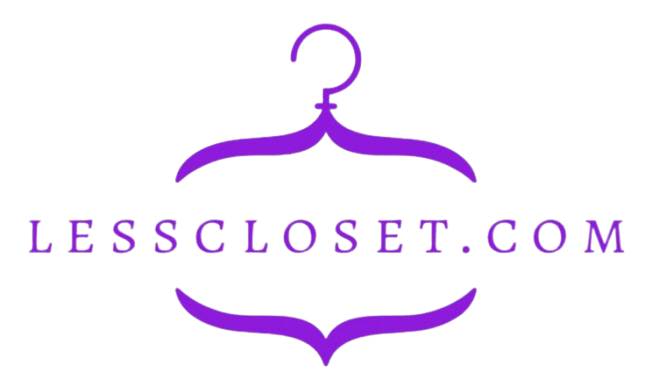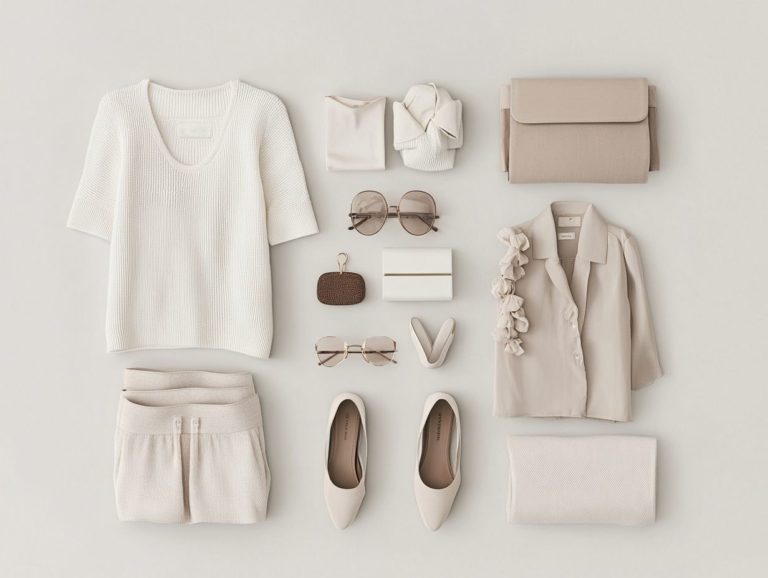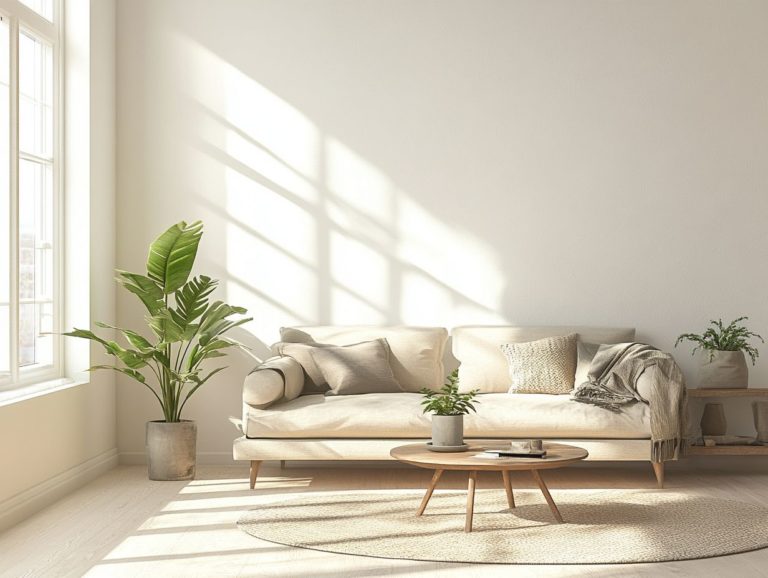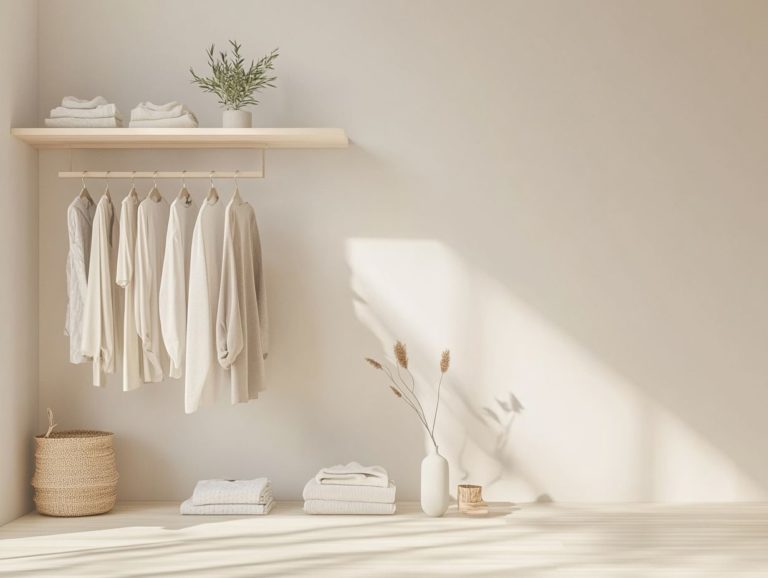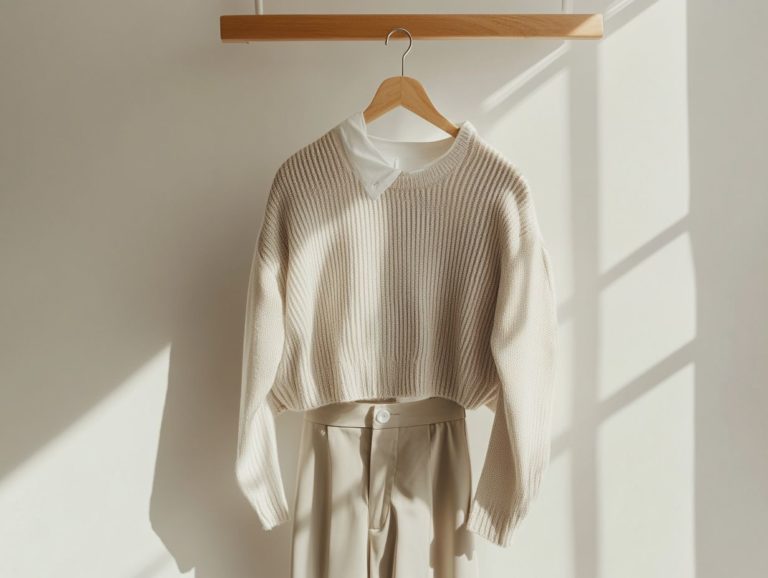7 Wardrobe Tips to Embrace Sustainable Minimalism
Contents
- Key Takeaways:
- 1. Invest in Quality, Versatile Pieces
- 2. Choose Timeless Styles
- 3. Stick to a Neutral Color Palette
- 4. Opt for Sustainable Fabrics
- 5. Embrace the Capsule Wardrobe Concept
- 6. Practice Mindful Shopping
- 7. Learn to Repurpose and Reuse Clothing
- How Can Minimalism Help Promote Sustainability?
- What Are the Benefits of a Capsule Wardrobe?
- How Can One Transition to a Sustainable Minimalist Wardrobe?
- What Are Some Common Mistakes to Avoid When Embracing Sustainable Minimalism?
- What Are Some Ethical and Sustainable Fashion Brands to Support?
- How Can Minimalism Extend Beyond Clothing to Other Aspects of Life?
- Frequently Asked Questions
- Curious about sustainable minimalism? Here’s what you need to know!
- What are the 7 wardrobe tips to embrace sustainable minimalism?
- How can decluttering your wardrobe contribute to sustainable minimalism?
- Why is it important to invest in quality and timeless pieces for your wardrobe?
- What are some sustainable alternatives to traditional shopping?
- How can embracing sustainable minimalism benefit the environment?
Key Takeaways:
- Invest in high-quality, versatile pieces to create a sustainable and minimalist wardrobe that will last longer.
- Choose timeless styles over trendy pieces to reduce the need for constant wardrobe updates.
- Stick to a neutral color palette to create a cohesive and versatile wardrobe that can be mixed and matched easily.
1. Invest in Quality, Versatile Pieces
Minimalist fashion encourages consumers to prioritize quality and versatility. This approach allows individuals to create a capsule wardrobe that reflects their style while avoiding the excesses of fast fashion.
Investing in high-quality garments enhances closets and reduces daily choices. This leads to less clutter and more mental space for other priorities.
Investing in sustainably produced pieces aligns with the growing awareness of ethical consumption. Choose a few high-quality items instead of many lower-quality ones for a more mindful life.
2. Choose Timeless Styles
Timeless styles are essential for a minimalist wardrobe because they are not influenced by short-term fashion trends. They contribute to a sustainable collection.
Timeless pieces typically feature clean lines, neutral colors, and high-quality materials, making them versatile and easy to pair with other items.
A well-cut blazer, a fitted white shirt, or classic denim jeans can seamlessly transition between different settings and times of day.
When combined creatively, these essentials allow individuals to express their unique personalities without the need for excess items in their closets.
Imagine the freedom of having a wardrobe where every piece works perfectly together! Layering a classic trench coat over a simple turtleneck or wearing a minimalist watch can help maintain a chic look.
3. Stick to a Neutral Color Palette
Adhering to a neutral color palette is fundamental to minimalist style. It simplifies outfit selection and encourages creative combinations.
By choosing shades such as beige, gray, and white, individuals can make quick decisions that minimize anxiety and save time during hectic mornings.
This strategy allows for the seamless incorporation of seasonal trends without necessitating a complete wardrobe overhaul.
To effectively mix and match neutral pieces, one can experiment with textures and layering. Pairing a soft cashmere sweater with structured linen trousers can create a polished yet cozy look.
Subtle-hued or metallic-toned accessories can provide just the right amount of flair, making each ensemble feel fresh and unique without overwhelming the overall aesthetic.
4. Opt for Sustainable Fabrics
Sustainable fabrics are essential for achieving minimalism while being eco-conscious. They mitigate the impact of fast fashion through superior quality and promote ethical clothing care and environmental responsibility. These fabrics come from natural or recycled materials and use fewer resources than traditional options. For instance, producing Tencel, made from sustainably sourced trees, uses 91% less water than cotton. Sustainable fabrics also avoid harmful chemicals like pesticides and dyes.
While sustainable fabrics can create trendy clothing, they are often more durable and comfortable. This increases the likelihood that they will be worn for an extended time. Brands like Patagonia and Eileen Fisher focus on sustainable fabrics and manufacturing processes to create timeless pieces that align with minimalist lifestyles. By investing in high-quality clothing, you can build a curated wardrobe that lasts beyond fleeting fashion trends.
Thanks to their superior quality, sustainable fabrics last longer and require less frequent washing, a key aspect of eco-minimalism. Longer-lasting garments contribute to sustainability by reducing the consumption of new materials and minimizing work and travel time. When washed, opt for cold water and air-dry whenever possible to extend their lifespan. Consequently, purchasing sustainable fabrics becomes a more positive decision over time.
5. Embrace the Capsule Wardrobe Concept
The capsule wardrobe is a curated collection of clothing designed to minimize stress caused by decision fatigue. It promotes minimalism through intentional living and gratitude for simplicity. Think of it as having a smaller selection of versatile pieces that you love.
This approach helps you focus on quality over quantity, encouraging you to select versatile pieces that can be easily mixed and matched. This simplifies your daily outfit choices.
Having fewer clothing items can help you discover and refine your personal style. It allows for greater creativity and highlights the drawbacks of clothing overconsumption.
Additionally, reducing the number of items creates a cleaner, less cluttered environment. This promotes mental clarity and enhances the appreciation for the items that truly bring joy to your life.
6. Practice Mindful Shopping
Mindful shopping is essential for those who want to be conscious consumers while making purchases that align with their minimalist lifestyles. It protects your financial situation and reduces physical clutter in your closet.
Mindful shopping involves setting strict spending limits and prioritizing quality over quantity. This allows you to navigate the overwhelming nature of modern shopping in a purposeful way. Take the time to see if an item is a necessity and if it will endure beyond a fleeting trend.
As a result, you can have a more intentional buying experience that enhances your personal aesthetic while supporting sustainable practices that benefit the planet. By choosing well-made, classic items, you invest in durability and longevity, ultimately reducing waste.
7. Learn to Repurpose and Reuse Clothing
Get creative and give new life to your clothes! Learning to repurpose and reuse clothing is fundamental to sustainable fashion and minimalist style. This practice helps you extend the life of your garments while decluttering and making environmentally friendly choices through clothing donations.
Not only does it nurture a responsible consumer mindset, but it also inspires abundant creativity and self-expression. For instance, an old button-up shirt can be transformed into a tote bag, or a college student might convert an old pair of jeans into trendy shorts. You can combine various fabric scraps to create stunning patchwork pieces.
Supporting sustainable brands that advocate for upcycling practices not only contributes to environmental preservation but also aids in the shift towards responsible consumerism. This movement celebrates the beauty of the old and the discarded.
How Can Minimalism Help Promote Sustainability?
Minimalism promotes sustainability by decreasing reliance on fast fashion, alleviating emotional exhaustion linked to material overconsumption, and encouraging practices that prioritize product quality and longevity over quantity.
Individuals who adopt a minimalist lifestyle often make more deliberate choices regarding their spending. They opt for durable and ethically manufactured items instead of disposable products that contribute to landfill waste.
This approach not only benefits the environment but also cultivates a lifestyle centered on mindfulness and appreciation for one’s surroundings. For instance, purchasing a few high-quality garments rather than filling a closet with numerous items satisfies personal desires while reducing the demand for production processes that consume extensive resources.
Creating a decluttered environment has been shown to enhance mental clarity and overall well-being. This underscores the close relationship between personal health and environmental health.
What Are the Benefits of a Capsule Wardrobe?
The advantages of a capsule wardrobe include a significant reduction in clutter, increased financial security through intentional purchases, and enhanced personal style discovery that fosters creativity and self-expression.
A capsule wardrobe streamlines the dressing process by providing a curated collection of essential items that are easily matched for quick outfit creation. With fewer choices, individuals experience less decision fatigue. This allows them to focus their energy on other important aspects of their day.
The principles of a capsule wardrobe align with those of minimalism, promoting sustainable and ethical fashion practices. Each item is carefully selected for its high quality, longevity, and the values it represents.
This approach not only encourages an intentional lifestyle but also cultivates a deeper appreciation for the details. Ultimately, it boosts confidence in one’s personal style.
How Can One Transition to a Sustainable Minimalist Wardrobe?
Building a sustainable minimalist wardrobe involves several key steps:
- Evaluate your existing wardrobe, including a thorough clothing inventory
- Prioritize quality over quantity
- Select essential items that align with both personal and sustainable criteria
The process begins with a thorough assessment of your clothing, shoes, and accessories. During this time, separate out items that are worn out or no longer reflect your personal style. This evaluation not only helps reduce your belongings but also provides insight into your preferences.
When making new purchases, prioritize versatile items that can be mixed and matched to create cohesive looks without leading to overconsumption. Supporting sustainable brands that prioritize sustainable and ethical practices ensures that your purchases reflect your individual and collective values. This ultimately results in a wardrobe that is both practical and representative of a mindful lifestyle.
Start your journey towards a sustainable wardrobe today!
What Are Some Common Mistakes to Avoid When Embracing Sustainable Minimalism?
The most common mistakes in practicing sustainable minimalism include reverting to fast fashion, failing to acknowledge the emotional exhaustion caused by too many choices, and not prioritizing effective clutter reduction strategies that help maintain a minimalist lifestyle.
Many individuals underestimate the significance of making thoughtful purchasing decisions that address both current desires and future sustainability needs. The overwhelming abundance of choices in today’s consumer landscape can lead to decision fatigue. This can quickly derail a person’s commitment to minimalist habits.
By reducing choices and focusing on essentials, one can foster an environment that promotes less clutter and enhances overall well-being. This contributes to a gratitude for less mindset.
In conclusion, embracing sustainability through minimalism is crucial for both personal and environmental health. Take proactive steps today to make a meaningful impact in your life.
What Are Some Ethical and Sustainable Fashion Brands to Support?
Supporting ethical and sustainable fashion brands fosters a more responsible fashion industry that prioritizes quality over quantity. It promotes mindful consumerism, aligning with eco-conscious choices. When you choose to back these brands, your purchases serve as a direct endorsement of their business models and values. Your support can transform the fashion industry!
Stella McCartney is a luxury fashion brand that is entirely cruelty-free and operates without harming the environment. Everlane offers complete transparency regarding the costs involved in making a product, detailing allocations for fabric, hardware, labor, taxes, and transportation. The brand also reveals the true cost of its products and provides full disclosure about the working conditions in the factories that produce them.
Reformation and Patagonia are two additional brands recognized for their commitment to sustainable sourcing and fair treatment of workers. Supporting these brands helps them gain a stronger foothold in the marketplace, enabling growth and a wider positive impact.
As the community of supporters expands, so does the demand for practices that are better for the planet and more equitable for workers. Join the movement!
How Can Minimalism Extend Beyond Clothing to Other Aspects of Life?
Minimalism promotes intentional living and helps reduce clutter in various aspects of life, including home décor, relationships, and personal projects. This approach can alleviate emotional exhaustion and enhance your overall quality of life.
By simplifying home organization, you may find fulfillment in creating simple, comforting spaces that inspire creativity and relaxation. Time management also becomes more effective when you focus on what is essential and prioritize fulfilling tasks.
Relationships can be enriched by concentrating on a select few meaningful connections, fostering deeper bonds and exchanging items that hold true value. Practicing minimalism in different areas of life can lead to a greater sense of gratitude and improved mental health.
Frequently Asked Questions
Curious about sustainable minimalism? Here’s what you need to know!
Sustainable minimalism is a lifestyle approach that embraces minimalism while prioritizing sustainability. It’s important for your wardrobe because it promotes conscious consumption and reduces waste in the fashion industry.
What are the 7 wardrobe tips to embrace sustainable minimalism?
- Declutter clothes regularly.
- Invest in timeless pieces.
- Shop second-hand or from sustainable brands.
- Utilize a capsule wardrobe, which is a small collection of versatile clothing items.
- Repurpose and upcycle old clothes.
- Care for your clothes properly to prolong their lifespan.
- Avoid fast fashion trends and opt for classic styles.
How can decluttering your wardrobe contribute to sustainable minimalism?
Decluttering your wardrobe helps you reassess your clothing needs and reduce unnecessary purchases. This leads to less waste and promotes a more sustainable approach to fashion.
Why is it important to invest in quality and timeless pieces for your wardrobe?
Investing in quality and timeless pieces ensures your clothes will last longer. It reduces the need for constant replacement and consumption, supporting sustainable fashion practices and promoting a more minimalist lifestyle.
What are some sustainable alternatives to traditional shopping?
Sustainable alternatives to traditional shopping include shopping second-hand, renting clothes, and supporting ethical and sustainable brands. These options reduce the demand for new products and support more eco-friendly practices in the fashion industry.
How can embracing sustainable minimalism benefit the environment?
Embracing sustainable minimalism benefits the environment by reducing clothing waste and pollution created by the fashion industry. It promotes more responsible and ethical practices, such as using sustainable materials and reducing carbon emissions.
Start your sustainable journey today for a brighter tomorrow!
